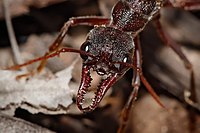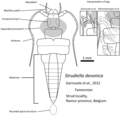Portal:Insects
The Insects Portal


abdomen), three pairs of jointed legs, compound eyes, and a pair of antennae. Insects are the most diverse group of animals, with more than a million described species; they represent more than half of all animal species. (Full article...)
Selected article -
Errata
Bookworm is a general name for any insect that is said to bore through books.
The damage to books that is commonly attributed to "bookworms" is often caused by the larvae of various types of insects, including beetles, moths, and cockroaches, which may bore or chew through books seeking food. The damage is not caused by any species of worm. Some such larvae exhibit a superficial resemblance to worms and are the likely inspiration for the term, though they are not true worms. In other cases, termites, carpenter ants, and woodboring beetles will first infest wooden bookshelves and later feed on books placed upon the shelves, attracted by the wood-pulp paper used in most commercial book production. (Full article...)Did you know -
- ... that Parachartergus apicalis will attack Camponotus atriceps if they try to tend their treehoppers?
- ... that the Philippine hornet Vespa luctuosa has the most lethal venom by weight of any known wasp species?
- ... that amber fossils of ants carrying the extinct mealybug genus Electromyrmococcus represent the oldest record of symbiosis between mealybugs and Acropyga ants?
- ... that the extinct Protosialis casca is one of only two known alderflies from the West Indies?
- ... that the bone skipper came back from the dead after 160 years to feed on rotting bones?
List articles
Related portals
General images -
The following are images from various insect-related articles on Wikipedia.
-
Insect morphology
Legend of body parts
Tagmata: A – Head, B – Thorax, C – Abdomen.)- subesophageal ganglion(from Insect morphology
- mouthparts
-
Queen Alexandra's birdwing (Ornithoptera alexandrae) of Papua New Guinea (from Insect biodiversity)
-
Closeup of a fire ant, showing fine sensory hairs on antennae (from Insect morphology)
-
Larva ofSyrphid fly, member of Cyclorrhapha, without epicranium, almost without sclerotisation apart from its jaws. (from Insect morphology)
-
The Odonata (dragonflies and damselflies) have direct flight musculature, as do mayflies. (from Insect flight)
-
A pie chart of described eukaryote species, showing just over half of these to be insects (from Insect biodiversity)
-
Mandibles of Rhyniognatha hirsti, it may be an oldest insect, but also possible to be a myriapod. (from Evolution of insects)
-
Frenulo-retinacular wing coupling in male and female moths (from Insect flight)
-
Diagram of a typical insect leg (from Insect morphology)
-
The abdominal terminus of malescorpionflies is enlarged into a "genital bulb", as seen in Panorpa communis (from Insect morphology)
-
Scanning electron micrograph of a cricket spiracle valve (from Respiratory system of insects)
-
Head of Orthoptera, Acrididae. a:antenna; b:ocelli; c:vertex; d:compound eye; e:occiput; f:gena; g:pleurostoma; h:mandible; i:labial palp; j:maxillary palps; k:maxilla; l:labrum; m:clypeus; n:frons (from Insect morphology)
-
Variety of male structures in Phlebotominae (Diptera, Psychodidae) (from Insect reproductive system)
-
Male genitalia of Lepidoptera (from Insect reproductive system)
-
Indian moon moth (Actias selene) with some of the spiracles identified (from Respiratory system of insects)
-
Generalized arthropod biramous limb. Trueman proposed that an endite and an exite fused to form a wing. (from Insect flight)
-
Cross-section of wing vein (from Insect morphology)
-
Mazothairos, a Carboniferous member of the now extinct order Palaeodictyoptera. (from Evolution of insects)
-
Evolution has produced astonishing variety of appendages in insects, such as these antennae. (from Evolution of insects)
-
Stylized diagram of insect digestive tract showing malpighian tubule, from an insect of the order Orthoptera. (from Insect morphology)
-
Hoverfly (Xanthogramma pedissequum) has indirect flight musculature. (from Insect flight)
-
Mayfly nymph with paired abdominal gills (from Insect flight)
-
Larva of beetle, family Cerambycidae, showing sclerotised epicranium; rest of body hardly sclerotised (from Insect morphology)
-
The development of insect mouthparts from the primitive chewing mouthparts of a grasshopper in the center (A), to the lapping type (B) of a bee, the siphoning type (C) of a butterfly and the sucking type (D) of a female mosquito.
Legend: a – antennae
c – compound eye
lb – labium
lr – labrum
md – mandibles
mx – maxillae (from Insect morphology) -
Venation of insect wings, based on the Comstock-Needham system (from Insect morphology)
-
Direct flight: muscles attached to wings. Large insects only (from Insect flight)
-
Bumblebee defecating. Note the contraction of the anus, which provides internal pressure. (from Insect morphology)
-
A tau emerald (Hemicordulia tau) dragonfly has flight muscles attached directly to its wings. (from Insect flight)
-
The female genitalia of Lepidoptera (from Insect reproductive system)
-
ReconstructionStrudiella devonica as a possible hexapod (from Evolution of insects)
Selected image -

The yellow fever mosquito, Aedes aegypti (Diptera: Culicidae), is a mosquito that can spread the dengue fever, Chikungunya and yellow fever viruses, and other diseases. It can be recognized by white markings on legs and a marking in the form of a lyre on the thorax.
WikiProjects

Main
WikiProject
:
Related projects:
- WikiProject Arthropods
- WikiProject Spiders
- WikiProject Animals
- WikiProject Tree of Life
- WikiProject Biology
Daughter projects:
Tasks
 |
Here are some tasks awaiting attention:
|
Associated Wikimedia
The following Wikimedia Foundation sister projects provide more on this subject:
-
Commons
Free media repository -
Wikibooks
Free textbooks and manuals -
Wikidata
Free knowledge base -
Wikinews
Free-content news -
Wikiquote
Collection of quotations -
Wikisource
Free-content library -
Wikiversity
Free learning tools -
Wiktionary
Dictionary and thesaurus
Discover Wikipedia using portals



















































